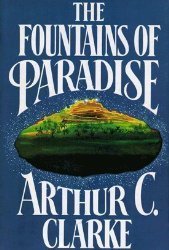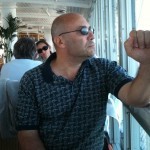The Fountains of Paradise – Arthur C. Clarke

 The Fountains of Paradise
The Fountains of Paradise takes place in a scenario typical of many novels from Clarke.
takes place in a scenario typical of many novels from Clarke.
We are about a hundred years in the future, in a solar system that begins to be colonized in a massive way, a situation, if not likely, at least possible. The novel has been published in 1979 and Clarke envisions a futuristic technology project that is no more science fiction: today, studies are conducted to turn that science fiction crazy idea into the reality of our present days. And it is not the first time it happens with envisioned futuristic technologies that ‘see’ the light first on the pages of a science fiction story.
The vision of what lies ahead is optimistic: according to Clarke in the future many current problems will be solved and the society will be more stable, but difficulties are never lacking, especially for those who want to break into new ground.
Taprobane is a small island full of history, often bloody, living a finally quiet present, bathed in light and in the heat of the equator.
The end of peace arrives in the unlikely role of an engineer, Vannevar Morgan, the bold and brilliant designer of the bridge across the Straits of Gibraltar, and it is the position of the island that makes it the candidate (or condemn it) to become the star of an extraordinary project.
Morgan is a visionary, capable of dizzying advances, but for what he has in mind words like bold and extraordinary are insufficient: the designer has in mind to build an elevator to the stars.
A space station in a geo-synchronous orbit, anchored to the ground with a long cable twenty-five thousand km, would lift to orbit heavy loads in a fraction of the cost and without harming the environment.
Unfortunately, only one point on Earth has the ideal characteristics for a safe anchorage, and right on the mountain chosen by Morgan has lived for centuries a community of Buddhist monks.
Even in a hyper-modern world, religion is a powerful force, and a ruling by the World Court prohibits building the Space Elevator anchored around the monastery.
Bitter defeat for Morgan, but it does not make him stop fighting, though now only a miracle could reverse the situation and allow him to realize his dream.
Clarke favors novels set in a not too distant future, when humanity has colonies and outposts on satellites and planets in the solar system. A great initial idea (the orbit elevator), developed with scientific rigor, a pinch of twists and maximum attention to the plot and logical development of the story, with these ingredients the English writer has packed several novels, almost all great. The Fountains of Paradise
The Fountains of Paradise is ridden with numerous difficulties and surprises, and a solo mission. The novel has a subtle charm, almost inexplicable, the only well developed character is the engineer, Morgan, the pace is anything but devilish and lovers of stories with plenty of action may be disappointed, but often it is not the case with Clarke.
is ridden with numerous difficulties and surprises, and a solo mission. The novel has a subtle charm, almost inexplicable, the only well developed character is the engineer, Morgan, the pace is anything but devilish and lovers of stories with plenty of action may be disappointed, but often it is not the case with Clarke.
The story lives on the idea of the orbit elevator and its technological descriptions. Clarke is a master at explaining technologies that nobody has ever seen, and inserts them into the story in a natural and imperceptible way.
Another element of interest are the references to the past and the contrast between the technological requirements and religion, a conflict that sees Clarke on the side of science.
The paradoxical way in which he solves the standoff between the Buddhist monastery and Morgan is the irrationality of religion, which is condemned by itself.
The novel has extraordinary descriptions of the landscapes and artistic treasures of Taprobane, and here Clarke plays at home: the island is modeled on a well-known one, since the writer has lived for more than half a century in Ceylon, the current Sry Lanka, and it’s the inspiration for Taprobane.
Ultimately, one of the best novels of one of the greatest science fiction writers.
Massimo Marino is a scientist envisioning science fiction. He spent years at CERN and The Lawrence Berkeley Lab followed by lead positions with Apple, Inc. and the World Economic Forum. He is also co-founder of “Squares on Blue”, a Big Data Analytics service company.
Massimo currently lives in France and crosses the border with Switzerland multiple times daily, although he is no smuggler.
As a scientist writing science fiction, he went from smashing particles at accelerators at SLAC and CERN to smashing words on a computer screen.
He’s the author of multi-awarded Daimones Trilogy.
His novels have received the Seal of Excellency from both AwesomeIndies.net and IndiePENdents.org
• 2012 PRG Reviewer’s Choice Award Winner in Science Fiction
• 2013 Hall of Fame – Best in Science Fiction, Quality Reads UK Book Club
• 2013 PRG Reviewer’s Choice Award Winner in Science Fiction Series
• 2014 Finalist – Science Fiction – Indie Excellence Awards L.A.
• 2014 Award Winner – Science Fiction Honorable Mention – Readers’ Favorite Annual Awards
His novels are available from Amazon, Barnes & Noble (Nook), iTunes Apple Store, and many other retailers around the world.
Join his mailing list for new releases, or follow him on Facebook, Google+, and Twitter.
The post The Fountains of Paradise – Arthur C. Clarke appeared first on § Author Massimo Marino.




